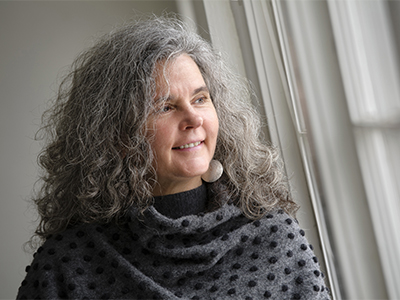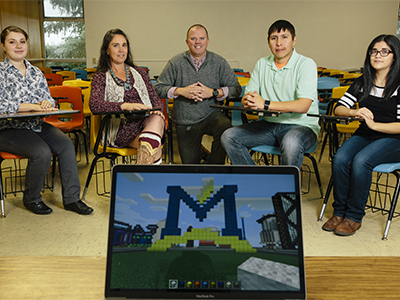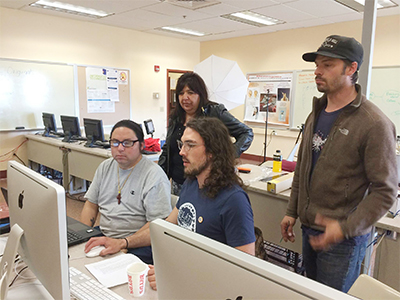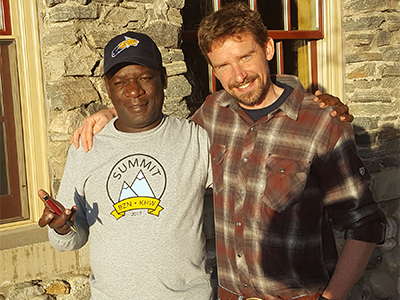Integration
Integration of learning, discovery and engagement and across disciplines is the marquee feature of the strategic plan. Traditionally, land-grant universities have educated students, conducted research and provided outreach to their communities and states. MSU has gone a step further by regularly integrating research and teaching, practicing service-learning and combining research with outreach. With this plan, MSU now boldly defines the 21st century land-grant university as one where learning, discovery and engagement merge seamlessly to the benefit of students, faculty, staff and the wider community.
Goal: By integrating learning, discovery and engagement, and by working across disciplines, the MSU community will improve the world.
Objective I.1: Increase the integration of learning, discovery and engagement.
Objective I.2: Increase work across disciplines.
Strategies
- Explicitly recognize integration in promotion and tenure documents and processes; hire and develop faculty who will pursue integrational and interdisciplinary research, instruction and engagement
- Strengthen support for student involvement in discovery and engagement in new and existing integrative programs
- Coordinate, foster and highlight Community Based Participatory Research projects, especially with Montana Tribal partners
- Identify key interdisciplinary research and creative themes for investment
- Revise space planning and policy to encourage promising interdisciplinary efforts to co-locate
Budget Alignment
(2017-18 investments unless otherwise noted):
- Annual Montana Experiment Station expenditures totaling over $15 million to create path breaking research and knowledge in support of and in partnership with Montana agricultural producers and communities
- $255,000 in ongoing base budget support for undergraduate research through the Undergraduate Scholars Program and other research projects
- $300,000 annually for the Center for Faculty Excellence to support faculty excellence in learning, discovery and engagement (also noted in Discovery)
- $70,000 committed in FY19 to develop co-curricular transcripts/e-portfolios to document and assess student engagement activities and learning outcomes outside the classroom (also noted in Engagement)
Successes
Research Applied
- In an exemplary community-based participatory research project, Beth Rink, an associate
professor inthe Department of Health and Human Development and a researcher with the MSU Center for American Indian and Rural Health Equity, won a five-year, $3.12 million grant from the National Institute on Minority Health and Health Disparities for “We Are Here Now,” a sexual and reproductive health randomized clinical trial for American Indian youth and their families on the Fort Peck Reservation in northeastern Montana. “We Are Here Now” is a term the Assiniboine and Sioux used for coming-of-age ceremonies in traditional times. In addition, Rink has been named a Fulbright Arctic Initiative Scholar to help advance Arctic nations’ shared interest in building resilient communities and sustainable economies.

Beth Rink, an associate professor in the MSU College of Education, Health and Human Development who conducts research with indigenous communities in Montana, Greenland and Finland, has won a pair of awards to further her work. MSU photo by Kelly Gorham
- More than a decade of work by MSU’s Center for Biofilm Engineering researchers has led to recommendations for new antimicrobial testing standards from the U.S. Environmental Protection Agency. These will help hospitals and other consumers select disinfectants that are effective against a wider range of bacteria. The standards are the first ever that apply specifically to bacteria that form biofilms - thin, slimy layers that can make microbes more resistant to traditional disinfectants.
- The ability to make spatial judgments and to perceive visual images accurately has
been shown to be a strong indicator of students’ future achievement in STEM courses,
but there is also evidence of a spatial intelligence gap between male and female students.
Montana State University education professors Nick Lux and Bryce Hughes, Brock LaMeres
in the Department of Electrical and Computer Engineering, Shannon Willoughby in theDepartment of Physics and a team of MSU students, high school teachers and researchers across the country have won $445,000 from the National Science Foundation to develop a new curriculum that uses a video game to help teach middle schoolers important spatial skills and bridge the gender gap.

MSU researchers are working to develop a curriculum based on the popular game Minecraft to improve the spatial intelligence of middle schoolers. MSU photo by Adrian Sanchez-Gonzalez
- MSU’s Center for Mental Health Research and Recovery received two grants from the state of Montana for evidence-based suicide prevention programs that involve MSU researchers, public schools, MSU Extension and local communities. The funded programs are among the most promising approaches for reducing suicide in the U.S.
- Montana State received more than $1 million in grants from the USDA to allow MSU to bolster training and outreach when it comes to integrated pest management, detecting new diseases and protecting crop exports destined for international trade. The grants support MSU’s Extension Integrated Pest Management Programs including the Schutter Diagnostic Laboratory, to foster applied research and Extension training opportunities for graduate and undergraduate students.
Expanding STEM horizons
Integrating learning, discovery and engagement to create a collaborative framework for more high-quality STEM learning for Montana youth, MSU’s STEM Summit brought together representatives from education, business, after-school providers, government and the larger community to discuss how Montana can build a strong science, technology, engineering and math ecosystem across Big Sky country.
Community-led

Students edit video as part of the Digital Storywork Partnership, an MSU project offering a series of filmmaking and research workshops to members of tribal communities who request them.
both from the Department of Education, along with MSU students and other partners, are part of the Digital Storywork Partnership, a collaboration offering a series of filmmaking and research workshops to members of Tribal communities who request them. In all collaborations in the partnership, all editorial decisions are made by the Tribal communities, including whether to invite the MSU professors and students to deliver workshops and the selection of the film topic. Learning to follow the lead of the tribal communities is a great learning opportunity for the participating MSU students.
Hatching Integrative Solutions at a Fish Hatchery
Responding to a need identified after stricter effluent requirements prompted the U.S. Fish and Wildlife Service to consider new treatment options for the Ennis hatchery, which produces about 20 million rainbow trout eggs annually for hatcheries nationwide, a team of researchers in MSU’s College of Engineering has partnered with the USFWS to study the use of treatment wetlands, which are relatively rare in the U.S. The first of its kind at a federal fish hatchery, the project that uses wetlands to treat effluent similarly to wastewater treatment could be emulated nationally.
Integration Changes Lives
Students in MSU’s chapter of Engineers Without Borders integrate learning, discovery and engagement through an

Maurice Arunga, left, and Adam Sigler reunited in Bozeman in November 2017, when Arunga visited MSU with nine other Kenyans who have been involved with MSU Engineers Without Borders. Photo courtesy Adam Sigler.
applied research project that uses disciplinary knowledge gained in the MSU curriculum to solve a community-defined need. The experience changes all of the participants. The relationship between one MSU-EWB student, Adam Sigler, and his Kenyan partner, Maurice Arunga, affected both men – Sigler engages the public in making scientific observations in his current work as a PhD student in environmental sciences and as an Extension water quality specialist, and Arunga was inspired to earn an architectural technician degree.
Rural Health Care
In an innovative academic and outreach partnership, Montana State University’s College of Nursing received a grant totaling nearly $2.8 million that will enable MSU and its partners from across Montana to address the need for nurses in shortage areas across the state, particularly in rural areas. The four-year grant from the U.S. Health Resources Services Administration is worth nearly $700,000 per year. The goal of the project is to prepare MSU College of Nursing students to practice in community-based primary care settings. The project will also provide professional development opportunities to current registered nurses around working in team-based settings, implementing care coordination systems and improving health in their communities.
